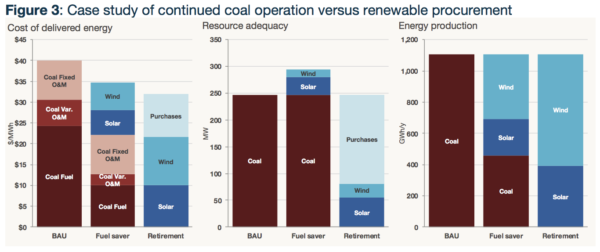Retiring 1.8 gigawatts (GW) of coal and replacing it with 2.5GW of solar and wind power would save Colorado-based Tri-State Generation and Transmission Association and its members $600,000,000 through 2030, according to a study published by the Rocky Mountain Institute (RMI). Tri-State provides wholesale power to 43 distribution co-operatives, which serve 1 million-plus consumers in Colorado, Nebraska, New Mexico, and Wyoming.
The study found that “the go-forward operations and maintenance costs” of Tri-State’s coal fleet, calculated from public data, “are now higher than prevailing prices for new renewable resources,” as shown in Figure 2. The bar chart shows the stacked costs for each coal unit, versus solar and wind costs as shown by dashed lines.
The dashed lines are based on solar bids (yellow) and wind bids (blue) as received by Xcel Energy in 2018, to which RMI added $3/MWh for incremental transmission costs, and $0.60/MWh for balancing energy costs, when adding renewables. RMI sourced these values from the utilities Xcel and Rocky Mountain Power, respectively. (RMI accounted for purchased firm capacity separately in its model, using a value from Xcel.)

RMI identified a low-cost scenario, based on a single 247MW coal unit, in which Tri-State would add 342MW of solar and wind power and retire the coal unit, thus eliminating all its operations and maintenance costs. Scaling up the renewables investment to all 1,800-plus MW of Tri-State coal units, to achieve $600,000 in savings, would require 2.5GW of solar and wind power. RMI assumed a gradual phase-out of coal units by 2026, with Tri-State procuring firm capacity to “cover the capacity gap left by coal retirement.” The result was “go-forward operating costs at the portfolio level” of $32 per MWh.
The study also considered a “fuel saver” scenario, again based on a single coal unit, which would add 100MW of solar and 100MW of wind power, and continue to run the 247MW coal unit for balancing power. That case also yielded savings, but not as much as retiring the coal unit.
These two scenarios are shown in Figure 3 alongside the “business as usual” scenario.

While the analysis “includes an assessment of the resource adequacy requirements necessary to meet Tri-State member loads in each future year assessed,” RMI did not have access to detailed operating information for Tri-State’s system, and so could not use “other means (e.g., power flow models) to assess other specific requirements.” Yet the report pointed to interconnect-level studies and integrated resource plans of regional utilities such as Xcel that “suggest no issues in maintaining system reliability with growing levels of renewable energy adoption.”
Tri-State spokesperson Lee Boughey said “The RMI report does not equate to the thorough resource modeling in our integrated resource planning, where we factor in resources, loads across our 43 member distribution systems, transmission constraints, reliability factors, and resource and fuel costs to credibly forecast and compare resource scenarios.” He added, “We encourage RMI to suggest scenarios and engage in our inclusive public process next year.”
The RMI report suggests that distribution co-ops across the West work with their providers—associations such as Tri-State—to “pursue a strategy of collective action, built on transparency and open dialogue, that can bring focused innovation, regionally appropriate solutions, and scaled buying power to the situation at hand.”
The report also points to several risks if Tri-State does not transition to renewables to minimize its costs, including risks of revenue loss (e.g., due to load defection by distribution co-op members), policy changes, and cost increases.
The study, A Low-Cost Energy Future for Western Cooperatives: Emerging Opportunities for Cooperative Electric Utilities to Pursue Clean Energy at a Cost Savings to Their Members, was written by RMI staff members Mark Dyson and Alex Engel, and includes a four-page technical appendix.
This content is protected by copyright and may not be reused. If you want to cooperate with us and would like to reuse some of our content, please contact: editors@pv-magazine.com.








By submitting this form you agree to pv magazine using your data for the purposes of publishing your comment.
Your personal data will only be disclosed or otherwise transmitted to third parties for the purposes of spam filtering or if this is necessary for technical maintenance of the website. Any other transfer to third parties will not take place unless this is justified on the basis of applicable data protection regulations or if pv magazine is legally obliged to do so.
You may revoke this consent at any time with effect for the future, in which case your personal data will be deleted immediately. Otherwise, your data will be deleted if pv magazine has processed your request or the purpose of data storage is fulfilled.
Further information on data privacy can be found in our Data Protection Policy.